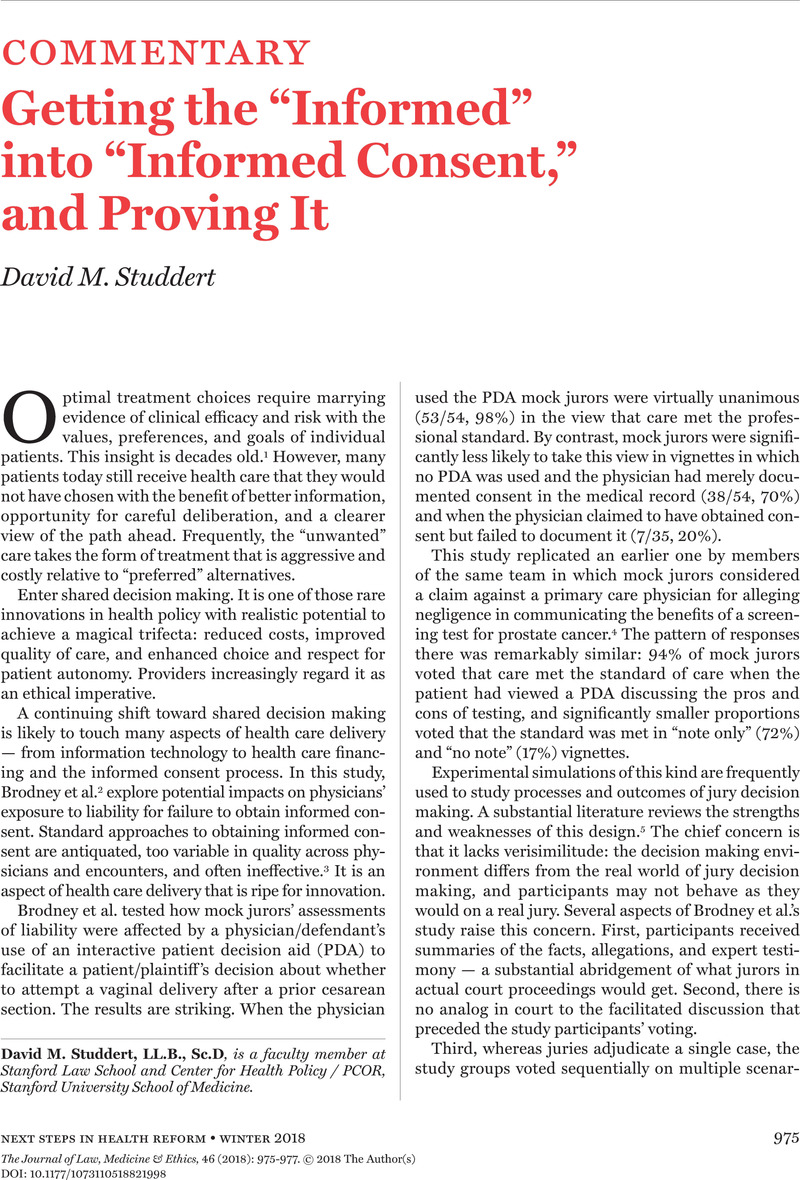No CrossRef data available.
Article contents
Getting the “Informed” into “Informed Consent,” and Proving It
Published online by Cambridge University Press: 01 January 2021
Abstract
An abstract is not available for this content so a preview has been provided. Please use the Get access link above for information on how to access this content.

- Type
- Independent Articles: Commentary
- Information
- Journal of Law, Medicine & Ethics , Volume 46 , Issue 4: Next Steps in Health Reform , Winter 2018 , pp. 975 - 977
- Copyright
- Copyright © American Society of Law, Medicine and Ethics 2018
References
McNeil, B., Weichselbaum, R., and Pauker, S., “Fallacy of the Five-Year Survival in Lung Cancer,” New England Journal of Medicine 299 (1978): 1397–1401.Google Scholar
Brodney, S., Westcott, P.H., Moulton, B.W., et al., “A Decision Aid May Offer Liability Protection for a Bad Obstetrical Outcome: Results of Mock Trials,” Journal Law, Medicine & Ethics 46, no. 4 (2018): 967–974.CrossRefGoogle Scholar
Bottrell, M.M., Alpert, H., Fischbach, R.L., and Emanuel, L.L., “Hospital Informed Consent for Procedure Forms: Facilitating Quality Patient-Physician Interaction,” Archives of Surgery 135, no. 1 (2000): 26–33; Lavelle-Jones, C., Byrne, D.J., Rice, P., and Cuschieri, A., “Factors Affecting Quality of Informed Consent,” BMJ 306, no. 6882 (1993): 885-890; J.W. Berg, P.S. Appelbaum, C.W. Lidz, and L.S. Parker, Informed Consent: Legal Theory and Clinical Practice, 2nd edition (New York: Oxford University Press, 2001).Google Scholar
Barry, M.J., Wescott, P.H., Reifler, E.J., Chang, Y., and Moulton, B.W., “Reactions of Potential Jurors to a Hypothetical Malpractice Suit: Alleging Failure to Perform a Prostate-Specific Antigen Test,” Journal of Law, Medicine & Ethics 36, no. 2 (2008): 396–402.CrossRefGoogle Scholar
Diamond, S.S., “Illuminations and Shadows from Jury Simulations,” Law and Human Behavior 21, no. 5 (1997): 561–571; Wiener, R.L., Krauss, D.A., Lieberman, J.D., “Mock Jury Research: Where Do We Go from Here?” Behavioral Sciences & the Law 29 (2011): 467–479; M.B. Kovera, The Psychology of Juries (Washington, DC: American Psychological Association, 2017).Google Scholar
Diamond, S.S., Rose, M.R., and Murphy, B., “Revisiting the Unanimity Requirement: The Behavior of the Non-Unanimous Civil Jury,” Northwestern University Law Review 100, no. 1 (2006): 201–230.Google Scholar
Bornstein, B.H., Golding, J.M., Neuschatz, J., et al. “Mock Juror Sampling Issues in Jury Simulation Research: A Meta-Analysis,” Law and Human Behavior 41, no. 1 (2017): 13–28.Google Scholar
Studdert, D.M. et al. “Claims, Errors, and Compensation Payments in Medical Malpractice Litigation,” New England Journal of Medicine 354 (2006): 2024–2033; Gogos, A.J., Clark, R.B., Bismark, M.M., et al. “When Informed Consent Goes Poorly: A Descriptive Study of Medical Negligence Claims and Patients Complaints,” The Medical Journal of Australia 195, no. 6 (2011): 340-344.Google Scholar
Id.; Bismark, M.M., Gogos, A.J., Clark, R.B., et al, “Legal Disputes Over Duties to Disclose Treatment Risks to Patients: A Review of Negligence Claims and Complaints in Australia,” PLOS Medicine 9, no. 8 (2012), available at <https://doi.org/10.1371/journal.pmed.1001283> (last visited November 13, 2018).CrossRefGoogle Scholar


